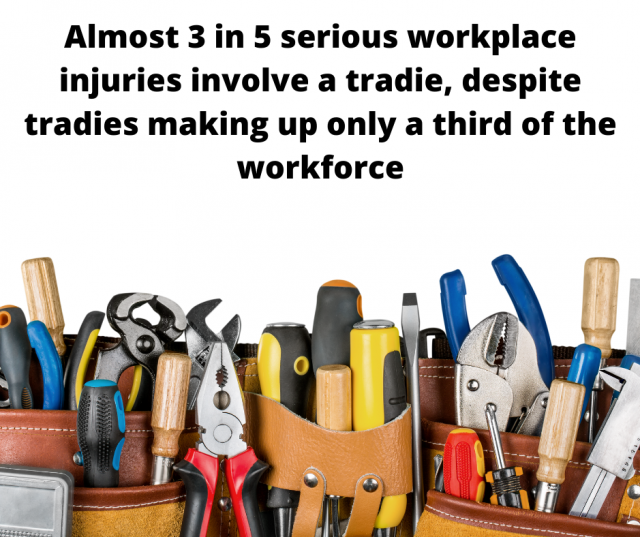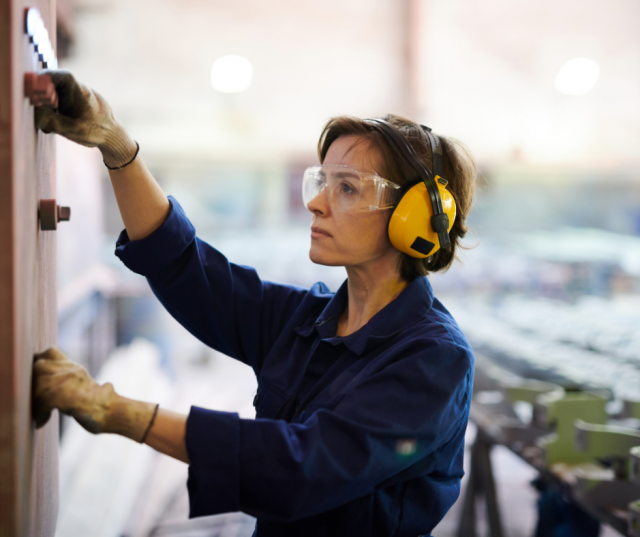News: Work Safer for Longer – Tradies National Health Month
By Dr Stefan Angelucci - Chiropractor
August is Tradies National Health Month. Did you know that, in Australia, tradespeople account for a whopping 30% of the total workforce, across many different fields.
As we know, being in a trade is very physically demanding: long hours on your feet, lifting heavy loads and getting into awkward positions. This often leads to a lot of injuries in the workplace and unwanted time off work, in fact people working in trades are the most injury prone group within the Australian work force.
In this article you will find out:
- The most common workplace injuries we see at the clinic
- What the most common causes of those injuries are
- Some useful tips on how to reduce the risk of having an injury at work
- How we can help support you to reduce your injuries and get you back to best as soon as possible
- In 2017-18, nearly 136,000 tradies encountered a workplace injury
- 43,555 claims were made for bodily stresses; 23% of these were from labourers
- Bricklayers and mechanical engineers made up 15% of total claims. Following in second was carpenters with 12.7%
- The most common injuries were musculoskeletal (muscle and joint) and the mechanism of injury was pushing, pulling, lifting or bending
- The most affected areas of injury were back and spine 35%, shoulder 15.2% and knee 14.6%
- There is some good news, the occurrence of workplace injuries has been declining year by year due to better policies within workplaces.
THE TRADIE PRESENTATION
Here at South Eastern Active Health we see a range of tradespeople, including plumbers, carpenters, electricians and bricklayers just to name a few. No matter what the trade, one thing that remains the same is the type of injury that Tradies commonly present with. This is most often due to poor lifting, pulling, pushing and bending activities and workplace trauma e.g. a falling onto an object or slipping on an uneven surface. Conditions that commonly affect Tradies due to workplace injuries are:
- Lumbar (Low back) and Cervical (Neck) disc or spinal injuries
- Muscle or tendon injuries, strains and tears, mainly in low back or neck areas
- Sciatica
- Bursitis
- Occupational overuse syndrome (formerly known as RSI)
HOW DO THESE INJURIES OCCUR?
Most of the injuries we see at the clinic occur via two pathways:
- The first is an acute traumatic injury. In most instances this happens when someone is not prepared to lift or move an object and the injury that occurs results in a high intensity and immediate onset of pain.
- The second is through occupational overuse. As we know, most tradies work long hours almost every day of the week, which causes the body to fatigue and in turn makes it more susceptible to injuries especially when the tasks they do are very repetitive.
Many of the injuries that we see are easily avoidable by implementing good workplace and home-based practices.
Let’s take a look at some tips to help reduce the risk of injury.
WORKPLACE INJURY PREVENTION TIPS
- Manual Handling – make sure you use correct lifting postures and techniques:
- PLAN your lift, ensuring that the weight you are lifting is suitable and not too heavy – it should not exceed 25kg (any heavier will require another person)
- POSITION the load evenly between your feet, which should be shoulder width apart, allowing you to adequately squat down
- PICK the object up using your legs (thigh and hip muscles) as they are big and strong muscle groups; keep the load as close as possible to your body
- PROCEED with caution as you carry/move the load; remain upright and be sure to avoid twisting, bending or reaching
- PLACE the object down in the reverse of the way you picked it up, again allowing the leg muscles to take most of the load
- Avoid overuse and allow the body to rest/recover. Work can become busy sometimes but it’s important to allow the body to adequately rest to allow you to work better for longer and not leave yourself more likely to get hurt.
- Regular Physical Therapy with your Chiropractor or Osteopath. This is important because it allows your practitioner to assess you body and address any issues so that your body is functioning to its optimum level. Just like you take you car to get serviced or go to the dentist to get your teeth checked, seeing your Chiro or Osteo also allows for any new or ongoing issues to be addressed as quickly as possible so you can continue working, or get back to work as soon as possible.
WHAT TO DO NEXT?
Being a Tradie is hard work! Unfortunately workplace injuries are a common part of the job and are something we see too often at the clinic. However, when an injury does occur, we are here to provide the best advice and treatment to help you recover, feel better and stronger as quickly as possible. Hopefully this information is a healthy introduction to you making some positive changes in your workplace – remember, prevention is always better than the cure!
If any of these issues affect you, scroll down to book an appointment with one of our qualified health professionals for an assessment.
We look forward to seeing you in the clinic soon.
STAY SAFE, STAY HEALTHY AND MOST OF ALL STAY ACLIVE!
References
Statistics and research | Safe Work Australia. (2021). Safe Work Australia. https://www.safeworkaustralia.gov.au/statistics-and-research
Workers’ compensation. (2020, July 23). Australian Institute of Health and Welfare. https://www.aihw.gov.au/reports/australias-health/workers-compensation
Muller, A., Pontonnier, C., Robert-Lachaine, X., Dumont, G., & Plamondon, A. (2020). Motion-based prediction of external forces and moments and back loading during manual material handling tasks. Applied Ergonomics, 82, 102935. https://doi.org/10.1016/j.apergo.2019.102935





